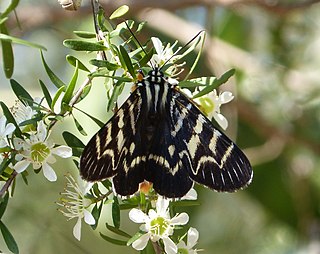
Orgyia is a genus of tussock moths of the family Erebidae. The genus was described by Ochsenheimer in 1810. The species are cosmopolitan, except for the Neotropical realm.

Orthonama obstipata, the gem, is a moth of the family Geometridae. The species was first described by Johan Christian Fabricius in 1794. It is a cosmopolitan species. In continental Europe though in the northeast, its range does not significantly extend beyond the Baltic region and it is absent from northern Russia. This well-flying species is prone to vagrancy and able to cross considerable distances of open sea; it can thus be regularly found on the British Isles and even on Iceland.

Crocidosema plebejana, the cotton tipworm, is a tortrix moth, belonging to tribe Eucosmini of subfamily Olethreutinae. It is found today all over the subtropical and tropical regions of the world and even occurs on many oceanic islands – in Polynesia and Saint Helena for example – but has probably been accidentally introduced to much of its current range by humans. In addition, it is also found in some cooler regions, e.g. in Europe except in the east and north; this is probably also not natural, as it was, for example, not recorded in the British Isles before 1900.
Cremnophora is a monotypic moth genus of the family Noctuidae erected by George Hampson in 1901. Its only species, Cremnophora angasii, was first described by George French Angas in 1847. It is found in South Australia.

Egybolis is a monotypic moth genus of the family Noctuidae erected by Jean Baptiste Boisduval in 1847. Its only species, Egybolis vaillantina, the African peach moth, was first described by Caspar Stoll in 1790. It is found in the Afrotropical realm.
Habrophyes is a monotypic moth genus of the family Noctuidae. Its only species, Habrophyes xuthosoma, is found in Australia where it is found in the Northern Territory and Queensland. Both the genus and species were first described by Alfred Jefferis Turner, the genus in 1920 and the species 11 years earlier in 1909.
Lophozancla is a monotypic moth genus of the family Erebidae. Its only species, Lophozancla prolixa, is found in Australia's Western Australia and the Northern Territory. Both the genus and the species were first described by Turner in 1932.
Olyssa is a monotypic moth genus of the family Erebidae. Its only species, Olyssa calamitosa, is found in Australia in Western Australia and the Northern Territory. Both the genus and the species were first described by Francis Walker in 1858.

Tathorhynchus is a monotypic moth genus in the family Erebidae erected by George Hampson in 1894. Its only species, Tathorhynchus exsiccata, the Levant blackneck or double-spotted snout, was first described by Julius Lederer in 1855. The nominate form is found on the Canary Islands and in North Africa, tropical Asia and tropical Africa. It has been introduced in Dominica and Argentina. Subspecies Tathorhynchus exsiccata fallax is found in the northern half of Australia, as well as Norfolk Island and New Zealand.
Birnara is a monotypic tussock moth genus in the family Erebidae erected by Arthur Gardiner Butler in 1879. Its only species, Birnara bicolor, was first described by Francis Walker in 1855. It is found in Sundaland in Southeast Asia.
Cimola is a monotypic moth genus in the subfamily Lymantriinae. Its only species, Cimola opalina, is found in South Africa. Both the genus and the species were first described by Francis Walker in 1855.

Crorema is a genus of moths in the subfamily Lymantriinae. The genus was erected by Francis Walker in 1855.
Icta is a genus of moths in the subfamily Lymantriinae. The genus was erected by Francis Walker in 1855. Both species are found in Australia.

Imaus is a genus of tussock moths in the family Erebidae. The genus was erected by Frederic Moore in 1879.

Iropoca is a monotypic moth genus in the subfamily Lymantriinae erected by Alfred Jefferis Turner in 1904. Its only species, Iropoca rotundata, the iropoca moth, was first described by Francis Walker in 1855. It is found in the Australian states of Victoria, New South Wales and Queensland.
Lacida is a genus of tussock moths in the family Erebidae. The genus was erected by Francis Walker in 1855.
Sarsina is a genus of moths in the subfamily Lymantriinae. The genus was erected by Francis Walker in 1855.
Varmina is a monotypic moth genus in the subfamily Lymantriinae described by Frederic Moore in 1888. Its only species, Varmina indica, was first described by Francis Walker in 1855. It is found in the East Indies.

Comocrus is a monotypic moth genus in the family Noctuidae erected by Karl Jordan in 1896. Its only species, Comocrus behri, the mistletoe moth or mistletoe day moth, was first described by George French Angas in 1847. It is widely distributed in southern Australia from Perth to Melbourne and adjacent to Bass Strait, occurring as far north as Derby, Western Australia, and Clermont and Rockhampton in Queensland. It may be seen during daylight hours hovering around mistletoe species such as Amyema miquelii, Amyema melaleucae and Amyema cambadgei growing on Casuarina and Eucalyptus trees. The adult moths feed on Eucalyptus flower nectar, have a wingspan of some 58 millimetres and are basically black with white bands running through the wings. Individuals ready to mate exhibit 'hill-topping' behaviour, flying to high points in the landscape and there encountering mates.
Lemyra maculifascia is a moth of the family Erebidae. It was described by Francis Walker in 1855. It is found in China, Indonesia, Timor, the Philippines, New Guinea and Australia. It is found in secondary habitats, including bush, clearings in primary forests and plantations, from the sea level up to elevations of about 1,200 meters.











